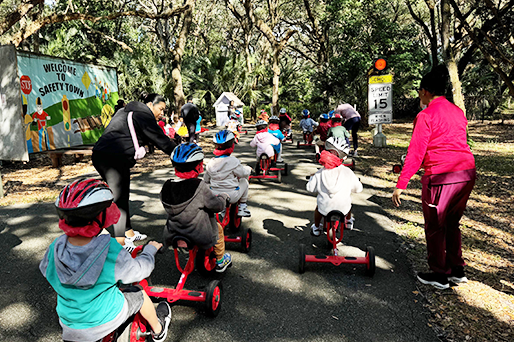Injury Prevention

Childhood Injury Prevention

In the United States, preventable injuries are the leading cause of death in children and young adults. According to the CDC, approximately 12,000 children and young adults, ages 1 to 19 years, die from unintentional injuries each year.
Below are tips and resources to learn how to prevent injuries in children.
Bicycle Safety Resources

Florida is the third most dangerous state in the country for cyclists. Children are at a particularly high risk for bicycle-related injuries. You can help keep your family safe while riding bicycles by:
- Ensuring everyone wears a properly fit helmet and bright colors
- Doing an “ABC” check before riding
- Following the rules of the road
- Riding predictably
Click on the following links for additional resources:

The majority of burns to young children occur in the home because parents underestimate the mobility and reach of toddlers and pre-school-aged children. According to the American Academy of Pediatrics, most childhood burns are preventable with awareness and burn prevention education.
Scalds remain the top injuries treated in emergency rooms for children under five. More than 200,000 children are burned each year from scalds, contact, and fire burns.
Here are some tips for parents and caregivers:
- Never carry your baby in your arms or a baby carrier while cooking, passing, eating, or drinking hot foods.
- Do not leave hot liquids or food within reach of children.
- Avoid using a microwave to heat your baby's bottle or food. Use warm water instead.
- Always test the temperature of heated bottles and food before feeding your infant.
- Only cook on back burners and turn pan handles away from the front of the stove.
- Secure your child away from the stove when you are cooking.
- Never leave your baby alone in the bathroom, not even for a minute.
- Run cold bath water first. Then add hot water, as needed, and stir.
- Set your water heater for 120°F or 49°C.
For more burn prevention tips, visit the Children’s Burn Foundation.
Car Seat Safety Resources

Approximately half of all car seats are installed incorrectly. Improper car seat installation can reduce the protective abilities of the seat during a crash. You can keep your family safe by:
- Getting your car seat checked by a certified child passenger safety technician (visit Safe Kids Broward or Florida Child Seat Safety for a list of inspection locations near you).
- Regularly check your car seat to ensure it is installed correctly and fits your child as they grow.
Click on the following links for additional resources:
On average, 38 children die in hot cars each year. A child’s body heats up 5x faster than an adult's, making them more vulnerable – which is why every second matters.
ACT to prevent heatstroke by following these tips to prevent your child from being left in a hot car:
- Avoid heatstroke-related injury: Always check the back seat before you leave the vehicle. Lock your vehicle and never let your children play in or near them so they can't let themselves in.
- Create reminders: Put your purse, briefcase, lunch, etc. in the backseat so you are sure to look before you lock the door.
- Take action: If you see a child alone in a car, call 911.
- Ask your childcare provider to call if your child doesn’t show up for care as expected.
- Rolling windows down or parking in the shade does little to change the interior temperature of the vehicle.
- If there is a change in plans and someone else is dropping your kid(s) off, have them call you at drop-off so you know everyone made it safely.
Motor Vehicle Safety Resources

Motor vehicle injuries are a leading cause of death among children and the most common reason teens aged 15-19 are admitted to the trauma center. However, many of these deaths can be prevented. To reduce the risk of serious injury and death, follow these tips:
- Properly buckle children in car seats, booster seats, or seat belts appropriate for their age and size.
- Regularly check your child's car seat to make sure it is installed correctly and fits your child as they grow (visit Safe Kids Broward for a list of inspection locations near you).
- Don't seat children in front of an airbag.
- Buckle children in the middle of the back seat when possible.
- Ensure that children are properly buckled in the back seat until age 13.
- Always choose a sober driver to transport your kids.
- Parents and caregivers can set a good example by always wearing a seat belt.
Click on the following links for additional resources:
Poison Prevention Resources

Poisoning is now a leading cause of injury death in Florida, and children under 5 years of age are the group most likely to have accidental poisoning, which can impact a child’s normal growth and development. The most common exposures include:
- Household cleaning products
- Pain medication
- Cosmetics
- Personal care products
America's Poison Centers is open 24/7 and represents 54 accredited poison control centers in the U.S. Follow these steps to help keep your family safe:
- Save their phone number (1-800-222-1222) and call for all exposure questions
- Store chemicals up and away so children and pets can't access them
- Store chemicals and cleaning products in their original containers
Click on the following links for additional resources:
Safe Infant Sleep Resources

Did you know that children under the age of one represent nearly 100% of unsafe sleep fatalities in Florida, making it a leading cause of preventable infant death in our state?
Sudden unexpected infant death (SUID) is the leading cause of injury death in infancy. Practicing safe sleep guidelines can prevent most SUID deaths in infants. Follow the ABCDs of safe sleep guidelines to keep your family safe:
- Alone: Babies should sleep alone in their own sleep space.
- Back: Babies should be placed on their backs to sleep.
- Crib: Babies should sleep in an empty sleep space that has a firm, flat mattress, and tight-fitting sheet.
- Develop: Develop a Safe Sleep Plan that describes where your baby will sleep, coping strategies to use when baby is fussy and who you can call for added support when you need help.
Click on the following links for additional resources:
Water Safety Resources

Drowning is the leading cause of unintentional death for children 1 to 4 years of age. It can happen in as little as two inches of water, within seconds, and is often silent. Keep your family safe near water by:
- Teaching children to swim
- Installing pool fences and door alarms
- Assigning a "water watcher"
- Wearing a life jacket
- Learning CPR
Click on the following links for additional resources:
- Drowning Prevention (Poster | Rack card)
- Pool Safety Checklist
- Swim Safety & Life Jacket Stand Flyer
General Injury Prevention Resources















